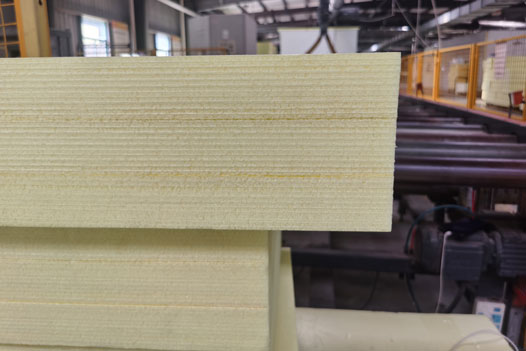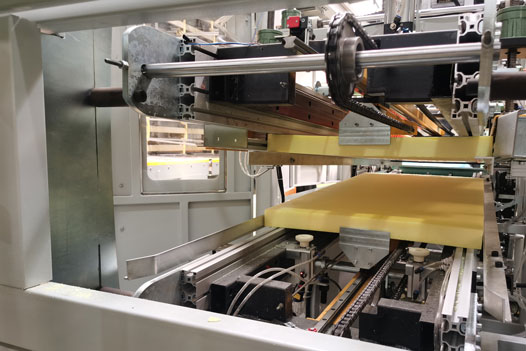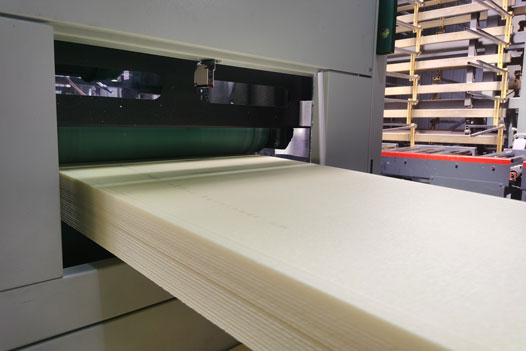Long-term commitment to the R & D and manufacturing of extruded board insulation materials, a new service platform
Production workshop feeding volume per hour 2 tons, daily output 1000 cubic meters

Composite special extruded board is based on traditional extruded polystyrene foam board (XPS) and compounded with other functional materials (such as fiber reinforcement layer, interface treatment layer, fire retardant coating, metal mesh, etc.) to form an upgraded product with multi-functional integrated characteristics. Its core advantage lies in making up for the performance shortcomings of a single extruded board (such as insufficient fire resistance, weak adhesion, easy surface cracking, etc.) through material composition, and is suitable for building or engineering scenarios with higher comprehensive performance requirements. The following is explained in terms of classification and construction, core performance, application scenarios, and advantage comparison:

1. Classification and typical structure
Depending on the differences in composite layer materials and functions, common types include:
1. Fireproof composite extruded board
Construction: XPS substrate + fireproof coating (such as inorganic fireproof mortar, aerogel coating) or fireproof insulation layer (such as rock wool, glass wool composite layer).
Features:
Improve combustion performance: Ordinary XPS is Class B2 (combustible), and after composite, it can reach Class B1 (refractory) or even Class A (non-combustible)(such as substrate + Class A fireproof material is fully covered).
Delay heat transfer: The fire protection layer blocks fire penetration and reduces fire risk.
2. Reinforced composite extruded board
Construction: XPS substrate + fiber reinforcement layer (such as alkali resistant glass fiber mesh cloth, carbon fiber cloth) or metal mesh layer (galvanized steel wire mesh).
Features:
Improve crack resistance: Prevent cracking of plates due to temperature changes or external forces, and enhance surface strength.
Improve adhesion: Fiber layer or metal mesh can improve adhesion with mortar, concrete and other substrates, and is suitable for external wall insulation systems.
3. Interface composite extruded board
Construction: XPS substrate + interface treatment layer (such as polymer mortar, coupling agent coating).
Features:
Solve the problem of smoothness of XPS surfaces: Ordinary XPS surfaces have low polarity, and the interface layer can enhance compatibility with adhesives and plaster mortar and reduce the risk of hollowing.
Suitable for thin plaster exterior wall insulation systems to improve overall stability.
4. Thermal insulation and decoration integrated composite extruded board
Structure: XPS substrate + decorative top layer (such as fluorocarbon paint, real stone paint, metal plate)+ adhesive layer.
Features:
Integrate insulation and decoration: reduce construction processes, reduce costs, and improve building aesthetics.
The top layer material provides impact resistance and weather resistance protection and extends service life.
5. Water-resistant composite extruded board
Structure: XPS substrate + waterproof coating (such as polyurethane waterproof coating, polymer waterproof film).
Features:
Further reduce the water absorption rate: The water absorption rate of ordinary XPS is ≤1.5%, which can be reduced to ≤0.5% after composite. It is suitable for humid environments (such as basements, kitchen and bathroom rooms).

2. Core performance advantages
performance dimensions Composite extruded board Traditional extruded board
fire rating Up to A/B1 level (depending on the composite layer) Normally Class B2 (flammable)
crack resistance Fiber/mesh reinforced with low risk of cracking The surface is easy to hollow and crack
bond strength Improved by 30%-50% after interface processing Requires additional interface processing
weather resistance Composite surface layer resists ultraviolet light, acid rain, etc. Long-term exposure is prone to aging
functional integration Thermal insulation + fire protection/decoration/waterproof, etc. All in one Single insulation function
construction efficiency Some types can shorten the construction period (such as integrated board) Multi-layer construction is required
3. Application scenarios
1. Building exterior wall insulation system
High-rise residential and commercial buildings: Use fire-proof reinforced composite extruded panels to meet fire code requirements and avoid cracking hazards of traditional XPS thin plaster systems.
Integrated insulation and decoration board: suitable for projects with high appearance requirements, such as office buildings and hotel exterior walls.
2. Special environmental engineering
Insulation of basement and swimming pool: Use water-resistant composite extruded board to prevent moisture penetration and reduce insulation performance.
Cold storage and cold chain storage: Extruded boards with composite fire protection layers can meet both low-temperature insulation and fire protection needs.
3. old house reconstruction project
The efficient thermal insulation of the composite extruded board can reduce the increase in wall thickness during renovation, and the reinforcement layer can adapt to the old grassroots level and reduce construction difficulty.
4. Time-sensitive projects
The integrated insulation and decoration board can achieve "one-time installation, dual functions", shorten the construction period, and is suitable for rush projects.
4. Core differences with traditional extruded boards
comparative dimension Composite extruded board Traditional extruded board
material composition Substrate + functional composite layer (more than 2 layers) Single XPS substrate
main function Multi-functional collaboration (such as insulation + fire prevention) single insulation
technical difficulties Interlayer adhesion, thermal expansion and cold contraction compatibility Composite layer-free matching problem
cost Higher (composite process + material cost) lower
applicable standards Must comply with relevant specifications for composite layers (such as GB/T 29906, etc.) Comply with GB/T 10801.2
V. Key points of selection and construction
1. Selection suggestions
1) According to fire prevention needs: Priority is given to high-rise buildings and crowded places to select Class A fire-proof composite panels (such as XPS + rock wool composite).
2) According to the basic conditions: old walls or structures with large deformation, select reinforced composite plates (with fiber mesh cloth) to improve crack resistance.
3) According to decoration needs: For projects that require aesthetic effects, an integrated insulation and decoration board can be selected, and the surface material can be selected according to the design style (such as imitation stone and metal texture).
2. construction precautions
1) Interface treatment: If the composite board has an adhesive layer, it is necessary to ensure that the base layer is clean and dry, and the adhesive is evenly coated.
2) Anchoring and fixing: High-rise exterior walls or areas with high wind pressure need to be fixed with anchors to avoid the composite layer falling off.
3) Joint treatment: The board joints need to be filled with elastic sealing materials to prevent rainwater from penetrating (especially in water-resistant composite board scenarios).
Summary
Composite special extruded boards have achieved performance upgrades and functional expansion through material innovation. The core value is to solve the limitations of traditional XPS in fire prevention, bonding, decoration, etc., and are especially suitable for high-standard building needs. When selecting a model, comprehensive considerations such as fire protection regulations, grassroots conditions, decoration style, budget, etc. of the project must be combined, and the compatibility of the composite layer and the substrate and long-term weather resistance test report must be paid attention to to ensure system stability.

1. Classification and typical structure
Depending on the differences in composite layer materials and functions, common types include:
1. Fireproof composite extruded board
Construction: XPS substrate + fireproof coating (such as inorganic fireproof mortar, aerogel coating) or fireproof insulation layer (such as rock wool, glass wool composite layer).
Features:
Improve combustion performance: Ordinary XPS is Class B2 (combustible), and after composite, it can reach Class B1 (refractory) or even Class A (non-combustible)(such as substrate + Class A fireproof material is fully covered).
Delay heat transfer: The fire protection layer blocks fire penetration and reduces fire risk.
2. Reinforced composite extruded board
Construction: XPS substrate + fiber reinforcement layer (such as alkali resistant glass fiber mesh cloth, carbon fiber cloth) or metal mesh layer (galvanized steel wire mesh).
Features:
Improve crack resistance: Prevent cracking of plates due to temperature changes or external forces, and enhance surface strength.
Improve adhesion: Fiber layer or metal mesh can improve adhesion with mortar, concrete and other substrates, and is suitable for external wall insulation systems.
3. Interface composite extruded board
Construction: XPS substrate + interface treatment layer (such as polymer mortar, coupling agent coating).
Features:
Solve the problem of smoothness of XPS surfaces: Ordinary XPS surfaces have low polarity, and the interface layer can enhance compatibility with adhesives and plaster mortar and reduce the risk of hollowing.
Suitable for thin plaster exterior wall insulation systems to improve overall stability.
4. Thermal insulation and decoration integrated composite extruded board
Structure: XPS substrate + decorative top layer (such as fluorocarbon paint, real stone paint, metal plate)+ adhesive layer.
Features:
Integrate insulation and decoration: reduce construction processes, reduce costs, and improve building aesthetics.
The top layer material provides impact resistance and weather resistance protection and extends service life.
5. Water-resistant composite extruded board
Structure: XPS substrate + waterproof coating (such as polyurethane waterproof coating, polymer waterproof film).
Features:
Further reduce the water absorption rate: The water absorption rate of ordinary XPS is ≤1.5%, which can be reduced to ≤0.5% after composite. It is suitable for humid environments (such as basements, kitchen and bathroom rooms).

2. Core performance advantages
performance dimensions Composite extruded board Traditional extruded board
fire rating Up to A/B1 level (depending on the composite layer) Normally Class B2 (flammable)
crack resistance Fiber/mesh reinforced with low risk of cracking The surface is easy to hollow and crack
bond strength Improved by 30%-50% after interface processing Requires additional interface processing
weather resistance Composite surface layer resists ultraviolet light, acid rain, etc. Long-term exposure is prone to aging
functional integration Thermal insulation + fire protection/decoration/waterproof, etc. All in one Single insulation function
construction efficiency Some types can shorten the construction period (such as integrated board) Multi-layer construction is required
3. Application scenarios
1. Building exterior wall insulation system
High-rise residential and commercial buildings: Use fire-proof reinforced composite extruded panels to meet fire code requirements and avoid cracking hazards of traditional XPS thin plaster systems.
Integrated insulation and decoration board: suitable for projects with high appearance requirements, such as office buildings and hotel exterior walls.
2. Special environmental engineering
Insulation of basement and swimming pool: Use water-resistant composite extruded board to prevent moisture penetration and reduce insulation performance.
Cold storage and cold chain storage: Extruded boards with composite fire protection layers can meet both low-temperature insulation and fire protection needs.
3. old house reconstruction project
The efficient thermal insulation of the composite extruded board can reduce the increase in wall thickness during renovation, and the reinforcement layer can adapt to the old grassroots level and reduce construction difficulty.
4. Time-sensitive projects
The integrated insulation and decoration board can achieve "one-time installation, dual functions", shorten the construction period, and is suitable for rush projects.
4. Core differences with traditional extruded boards
comparative dimension Composite extruded board Traditional extruded board
material composition Substrate + functional composite layer (more than 2 layers) Single XPS substrate
main function Multi-functional collaboration (such as insulation + fire prevention) single insulation
technical difficulties Interlayer adhesion, thermal expansion and cold contraction compatibility Composite layer-free matching problem
cost Higher (composite process + material cost) lower
applicable standards Must comply with relevant specifications for composite layers (such as GB/T 29906, etc.) Comply with GB/T 10801.2
V. Key points of selection and construction
1. Selection suggestions
1) According to fire prevention needs: Priority is given to high-rise buildings and crowded places to select Class A fire-proof composite panels (such as XPS + rock wool composite).
2) According to the basic conditions: old walls or structures with large deformation, select reinforced composite plates (with fiber mesh cloth) to improve crack resistance.
3) According to decoration needs: For projects that require aesthetic effects, an integrated insulation and decoration board can be selected, and the surface material can be selected according to the design style (such as imitation stone and metal texture).
2. construction precautions
1) Interface treatment: If the composite board has an adhesive layer, it is necessary to ensure that the base layer is clean and dry, and the adhesive is evenly coated.
2) Anchoring and fixing: High-rise exterior walls or areas with high wind pressure need to be fixed with anchors to avoid the composite layer falling off.
3) Joint treatment: The board joints need to be filled with elastic sealing materials to prevent rainwater from penetrating (especially in water-resistant composite board scenarios).
Summary
Composite special extruded boards have achieved performance upgrades and functional expansion through material innovation. The core value is to solve the limitations of traditional XPS in fire prevention, bonding, decoration, etc., and are especially suitable for high-standard building needs. When selecting a model, comprehensive considerations such as fire protection regulations, grassroots conditions, decoration style, budget, etc. of the project must be combined, and the compatibility of the composite layer and the substrate and long-term weather resistance test report must be paid attention to to ensure system stability.